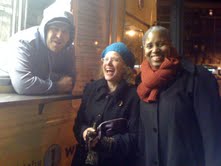In response to current proceedings on Capital Hill, some Christians are fasting in order to call attention to inequity reflected in the current budget proposals. Bread for the World president Rev. David Beckmann, Sojourners founder Rev. Jim Wallis, and NY Times food blogger Mark Bittman are all publicly fasting.
Now, I know that in Matthew's Gospel, Jesus warns against publicizing one's fast. He said,
Beware of practicing your piety before others in order to be seen by them; for then you have no reward from your Father in heaven... And whenever you fast, do not look dismal, like the hypocrites, for they disfigure their faces so as to show others that they are fasting. Truly I tell you, they have received their reward. But when you fast, put oil on your head and wash your face, so that your fasting may be seen not by others but by your Father who is in secret; and your Father who sees in secret will reward you. (Matt. 16:1, 16-18)Of course, we should not be fasting so that we look pious and gain others' respect. The purpose of fasting is to set aside more time for prayer and to improve our focus on God. Jesus' warning to not to use fasting for our own ends or personal glorification is very appropriate. Yet this is not what faith leaders are doing right now. St. John Chrysostom wrote that time spent fasting is time apart from the distractions of the world. Accordingly, in this article, Rev. Wallis says he is using his time that would otherwise be spent eating to gather with Christians and pray.
By fasting, Revs. Wallis and Beckmann are standing in solidarity with those who do not have enough to eat. They are calling attention to the problem of hunger in America, and protesting the current budget proposal that would severely reduce funding for food stamps.
Last summer, I was a camp counselor at a youth center in Cambridge. The state-provided lunches that the kids received were pretty unpleasant. Baloney sandwiches with soggy buns, shredded beets, "potato salad" that looked like a small lump of mush... if you can make it taste nasty, these kids got it. Most of the kids turned up their noses at the lunches. Some of them had lunches packed by parents, while others bought 15-cent Cup-O-Noodles packages at the corner store. A few kids ate the lunches and went back for seconds. Those kids didn't have enough to eat at home. One of the girls, Kay,* didn't have anyone at home who cooked; she got dinner by going to her aunt and grandmother's house. Kay was aware that only the poor kids ate the state lunch and would throw it away even when she told me she was hungry. She wouldn't eat when she was going to her aunt's in the evening, but when she was going home, she would quickly consume all the food offered to her.
"Hunger in America" is just a concept until you meet a hungry child. Now when I think about food stamp reduction, I wonder how many hungry and under-nourished kids at the youth camp will be affected. Maybe they won't even be able to buy their daily
In this time of Lent, often fasting is taken lightly. We mildly deprive ourselves of small luxuries such as chocolate and Netflix. The spiritual power of fasting, however, comes when we experience real deprivation such as loss of food and sleep. Acute physical discomfort grabs our attention in ways other small annoyances cannot. This Lent, our faith leaders are fasting in order to call attention to a deadly serious issue in our society today.
I can't join them in fasting, because I don't function well with low blood sugar. But I join them in spirit. This fast is not a political demonstration. It's a deeply spiritual exercise begun out of concern for those in America whose voices are not heard. And it is begun out of respect for God's justice. God cares that all people's needs are met, and God is angered when those with more resources hoard them from others who have less. As a person who cares about what God cares about, I must ask myself: what can I do as part of my spiritual practice to model God's justice? Are any of my daily habits hurting my poorer neighbors? This Lent, I am called to ponder my relationship with my neighbors and to think about what kinds of spiritual practices might call others to do the same.
* Name changed.











